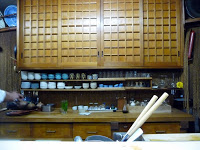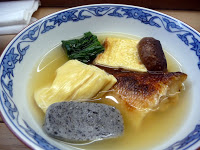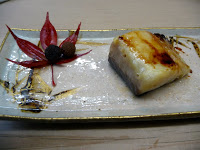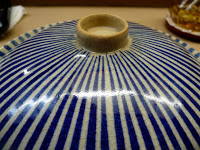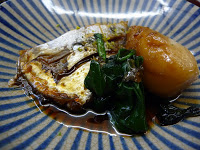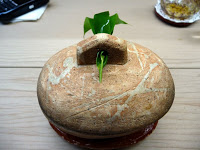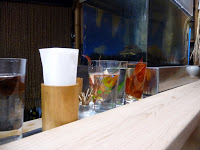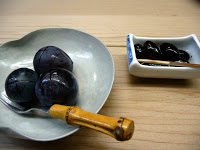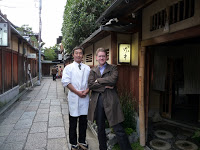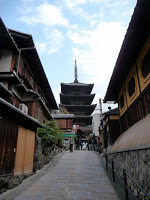 There’s nothing like 8 courses of kaiseki to pep you up from walking around looking at red leaves and tide you over until dinner. I mean, I already felt pretty peppy from walking around this neighborhood (for reference, this is the bit on the mid-east side of Kyoto, north of Kiyomizudera and south of Yasaka jinja – ninenzaka, sannenzaka, etc). Cobbled alleys and surprise views of pagodas always make me happy. You?
There’s nothing like 8 courses of kaiseki to pep you up from walking around looking at red leaves and tide you over until dinner. I mean, I already felt pretty peppy from walking around this neighborhood (for reference, this is the bit on the mid-east side of Kyoto, north of Kiyomizudera and south of Yasaka jinja – ninenzaka, sannenzaka, etc). Cobbled alleys and surprise views of pagodas always make me happy. You?
There were a lot of places to eat, especially near the Yasaka end of the area, where I started (for example, the famous Kikunoi is there – I stumbled across it but didn’t think they’d be that welcoming of unreserved guests). I held out until I saw this place, which said nothing but “We don’t always have food, but when we do it’s good” in 4 languages, and ‘Y5000’ in Japanese only.
Inside had a funny dark and damp feel despite being warm and dry, and the waitress told me that lunch was 7 courses. There are some private rooms and then this small counter, which was fairly peopled when I got there.
Fried tofu starter. This was terrific on accounta the stock. I love it when a place makes good stock.
These hooks were hanging from the ceiling above the kitchen side of the counter. I’d like to think they were originally for whale fishing.
Sometimes I think that Kyoto food is about disguising ordinary ingredients to seem more interesting, or else using extraordinary ingredients in a way that renders them disinteresting. This is raw squid, minced in strips, then carefully formed into a cylinder. Into that, as you can see, goes the yolk of a quail egg. These are very ordinary ingredients (seriously – if you’re reading in America, you wouldn’t believe how easy it is to get quail eggs in Japan), but put together this way you get to call it “Bird’s nest style”.
This is a pleasant but difficult boiled course. Pleasant because it tasted good and the ingredients are very healthy – the gray thing is fu (wheat gluten) with black beans, then going clockwise there’s dried, re-hydrated tofu skin, spinach, fried tofu, and a piece of fish. The chef criticized my eating style here – after a few bites he told me it’s a special Kyoto fish, it’s too hard to debone (the spine and main bones were all there in a layer; he had taken off only one filet), and you should eat it by picking up, biting softly, then pulling so the bones stay in one piece and come out of your mouth. At least I think that’s what he said. The skin was tough and the bones were many, but years in Japan have innured me to these travails, and I ate the whole thing. Around this time an elderly waitress popped up, seemingly just to say “Wow, you really use chopsticks well!” and then disappear.
Finally, good sawara. Sawara is usually overdone to my tastes, even in very nice restaurants. I think it’s stylistic. This was still a touch clear in the middle. The brown nubs on the maple leaf are pickled mountain peaches, to be eaten at the end to clear your palette.
Again, we add excitement to otherwise perfectly normal dishes by serving them covered and saying it’s “Umbrella style” (I’m not making this up).
Helloooooo baby. Can’t remember what the fish was. I believe it was shrimp potato, since I was in Kyoto and it’s evidently the season where that gets included in every meal! Boiled in sweet soy sauce, delicious.
Arrrrr. I don’t know why, but this crock, which was cooked as it is on the grill and then adorned with a leaf, made me think of buried treasure on a tropic isle. Avast!
So inside was minced fish and julienne daikon, cooked together and then ‘sealed’ with egg and topped with prickly ash. Or so I thought. The chef was a little offended – the ‘minced fish’ was actually hamo, a special type of eel that’s famous in Kyoto and hard to serve (you need a special knife to cut the abundant bones, and some practice too) and thus a luxury ingredient. The daikon was actually udo, an odd root vegetable (you would know it best from ‘udo sumiso’, which you would have experienced as thin rectangles of crunchy raw root vegetable, with a yellow sweet-and-sour sauce, in the Spring). And it was actually Kyoto udo, which is far superior because of its pure white color and lack of ‘scum’ that needs to be removed by soaking. But y’know, it tasted pretty normal considering how fancy the ingredients were. I didn’t ask where the eggs came from.
Lots of seasonal leaves. And a fish tank. Really a funny little room; food that’s intended to be grand, delivered in a tiny, dusky, humble setting.
Again I made the ingredient mistake. These grapes look just like the famous late-summer specialty from Yamanashi, kyoho. I asked where he sourced kyoho in late November. I was corrected. These are NOT kyoho. They are another type of grape that comes from farther south, and, being very good, are naturally not distributed to Tokyo. Similarly, these are not just black beans. They’re called ‘grape beans’ and did have a lovely grapey taste – but I’m not sure if that was because of their DNA or because they were cooked in grape juice (possible). Either way, what a great finish to the lunch – so simple, so humble…I’m just kidding. You know I always say that when I get fruit for dessert. I had to go out and get some ice cream.
I was happy with lunch here, but unless dinner was a big step up in quality, I’d be pretty bummed about tripling the price.
Any kaiseki just outside a temple has to be OK, no?
07-5551-3211

